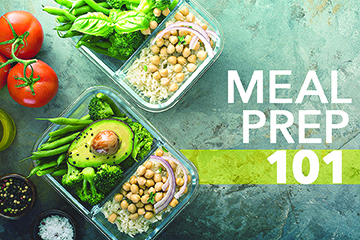by Rosalie Shanks, Registered Dietitian and a Lifestyle Coach, YMCA of Metro Denver
Meal prepping can sound like a daunting task, but its purpose is just the opposite — to make your life easier. Less desirable food choices are often made when hunger levels are high, and time is limited.
Let’s face it, it’s much easier to pick up pizza on the way home from work than to cook dinner from scratch. Like all nutrition recommendations, meal planning requires an individualized approach. It’s important to find out what works for you and your lifestyle! Here are some helpful tips to get you started.
Shop Smart
• Take inventory of your refrigerator, freezer and pantry before making a grocery list.
• Keep your grocery list simple and plan for meals that have similar ingredients throughout the week.
• Organize your list based on the main food groups (fruits, vegetables, lean meat, dairy, whole grains, healthy fats) to ensure a balanced meal plan.
Make The Healthy Choice
The Easy Choice
• After grocery shopping, rinse and cut fruits and vegetables for an easy grab-and-go snack. Store the prepped produce in a clear container at the front of your refrigerator as a helpful visual cue.
Batch Cook
• Batch cooking means cooking staple foods in a large batch to use in multiple dishes. If you are interested in trying batch cooking, a good place to start is with meat, grains and beans.
• For example, instead of cooking one cup of quinoa for dinner, make several cups. Have the quinoa as a side for dinner that night, add it to your salad for lunch, make a grain bowl, use it in a frittata, bake a casserole, or throw it in a soup.
Stick To The Basics
• Choose recipes that meet your needs, whether it’s family favorites, 30-minute meals or plant-based recipes.
• Pick a few staple recipes that you enjoy and already know how to make. When you don’t have time to try something new, use these types of recipes as your back-up plan.
• Opt for a recipe with little prep and clean up, such as a sheet-pan meal.
Plan For Leftovers
• Avoid the worst part of cooking — the clean-up. Double or triple your recipe and freeze it for a busy day down the road. Foods that freeze well include soups, casseroles, burritos, chicken, meatballs and breads. Avoid freezing cream-based meals or produce with a high water content.
Utilize Technology
There are endless recipes, apps and tips and tricks at your fingertips! Listed below are a couple of meal-prep apps for smart devices.
• The app Yummly creates a recipe with ingredients you already have at home.
• The app Mealtime has a variety of different recipes that will adjust to any food preference. You can select a few recipes to make for your week and it will populate a grocery list.
Meal prepping can save time and money, improve health outcomes, reduce food waste, add variety to your weekly meals and lower stress around the never-ending question, “what’s for dinner?” There is no right or wrong way to meal prep, the goal is not to start from zero each night!
Visit https://www.denverymca.org/ to learn more about fitness and nutrition programs at the YMCA of Metro Denver.

